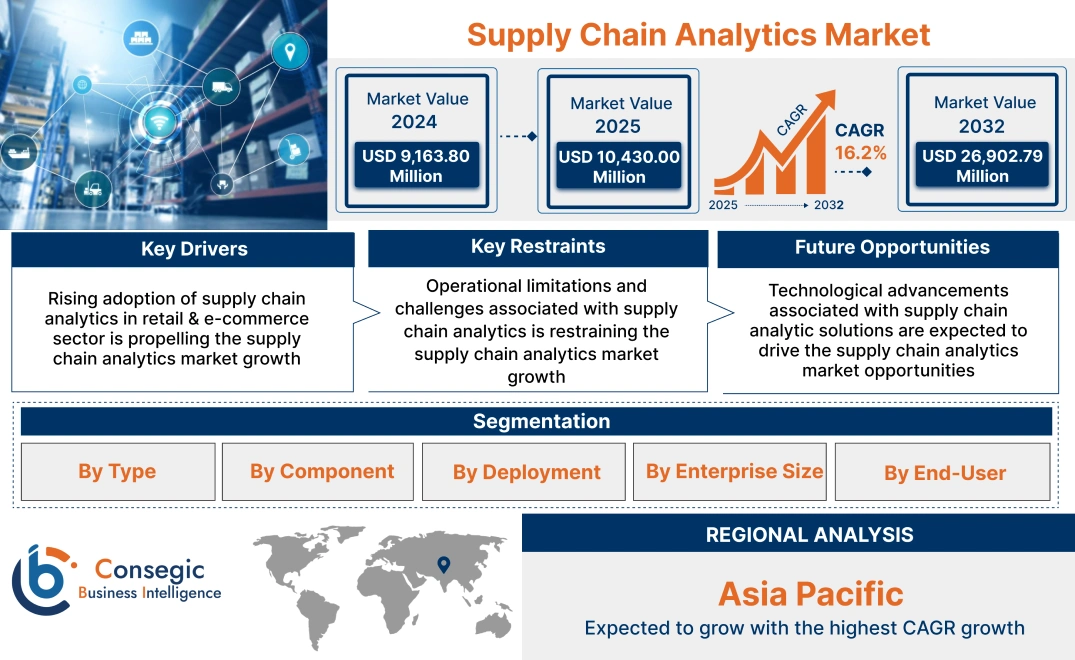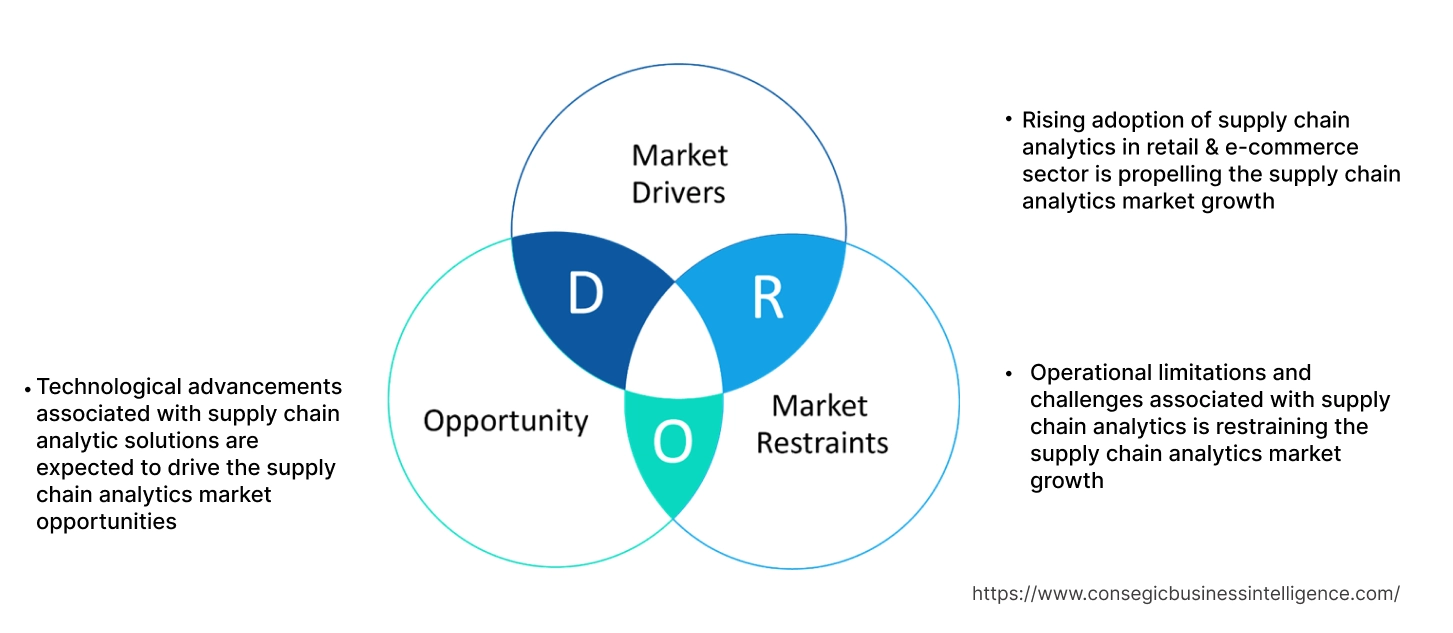- Summary
- Table Of Content
- Methodology
Supply Chain Analytics Market Size:
Supply Chain Analytics Market size is estimated to reach over USD 26,902.79 Million by 2032 from a value of USD 9,163.80 Million in 2024 and is projected to grow by USD 10,430.00 Million in 2025, growing at a CAGR of 16.2% from 2025 to 2032.
Supply Chain Analytics Market Scope & Overview:
Supply chain analytics (SCA) refers to the utilization of data analysis techniques for evaluating and optimizing the performance of a business organization's supply chain processes. It primarily involves the collection, analytics, and interpretation of data from several stages of the supply chain, including procurement, manufacturing, distribution, and inventory management. Moreover, supply chain analytics offer a range of benefits such as greater operational visibility, enhanced demand forecasting, improved inventory management, improved decision-making, and increased operational efficiency among others.
Key Drivers:
Rising adoption of supply chain analytics in retail & e-commerce sector is propelling the supply chain analytics market growth
Supply chain analytics solution is primarily used in retail and e-commerce sector for improving operational efficiency, enhancing customer satisfaction, and maximizing profitability. SCA solutions enable retailers to have a clear view of their supply chain operations, ranging from supplier performance to delivery status of products. Moreover, the utilization of SCA solutions in retail & e-commerce sector provides numerous benefits such as improved inventory planning, optimum stock levels, improved demand forecasting, logistics optimization, improved supply chain visibility, and others.
- For instance, according to the S. Census Bureau (Department of Commerce), the retail e-commerce sales in the United States was valued at USD 300.05 billion during the third quarter of 2024, representing a significant increase of 7.4% in comparison to USD 279.51 billion during the third quarter of 2023.
Hence, the growing retail & e-commerce sector is driving the adoption of supply chain analytic solutions for optimizing supply chain operations and improving operational efficiency, in turn proliferating the supply chain analytics market size.
Key Restraints:
Operational limitations and challenges associated with supply chain analytics is restraining the supply chain analytics market growth
The implementation of supply chain analytic solution is often associated with certain operational limitations and challenges, which are among the primary factors restraining the market. For instance, business enterprises may encounter various difficulties and challenges while using supply chain analytic solutions such as complexity in data integration, lack of uniformity, security and privacy concerns, supply chain complexity, and others.
Moreover, integration of data from several sources can be challenging as business enterprises frequently employ various systems and programs for various supply chain operations. Additionally, it may be challenging for comparing the efficacy of numerous suppliers or logistics providers due to lack of standardization in data gathering and analysis. Further, supply chain analytic solution also involves storing sensitive data, such as personal or financial data, which may raise security and privacy concerns, particularly for cloud-based deployment. Thus, operational limitations and challenges associated with supply chain analytic solutions are hindering the supply chain analytics market expansion.
Future Opportunities :
Technological advancements associated with supply chain analytic solutions are expected to drive the supply chain analytics market opportunities
Supply chain analytic solution providers are frequently investing in the development of new technologies associated with SCA solutions to ensure its safe and effective utilization in several industries such as manufacturing, retail & e-commerce, transportation & logistics, and others. As a result, supply chain analytic solution providers are launching new solutions integrated with advanced technologies and features such as artificial intelligence (AI), machine learning, and others, which is providing lucrative aspects for market development.
- For instance, in December 2023, Blue Yonder Inc. launched a new generative AI capability for significantly simplifying supply chain management and orchestration for businesses. The generative AI capability enables companies to make more intelligent decision-making and optimize supply chain operations. The generative AI capability for supply chain management enables business enterprises to quickly access predictive insights, recommendations, and intelligent decisions to ensure that they generate the ideal outcomes that impact their supply chain positively.
Thus, the rising technological advancements associated with supply chain analytic solutions are projected to drive the supply chain analytics market opportunities during the forecast period.
Supply Chain Analytics Market Segmental Analysis :
By Type:
Based on type, the market is segmented into predictive analytics, descriptive analytics, prescriptive analytics, diagnostic analytics, and others.
Trends in the type:
- Rising adoption of predictive analytics by business enterprises for facilitating improved operational visibility, enhanced decision-making, and optimized supply chain operations.
- Increasing utilization of prescriptive analytics for analyzing data and recommending the optimum course of action or strategy for businesses.
Predictive analytics segment accounted for the largest revenue share in the overall market in 2024, and it is anticipated to register substantial CAGR growth during the forecast period.
- Predictive analytics integrates machine learning and statistical algorithms for analysis of historical data and market trends along with forecasting future outcomes.
- Predictive analytics plays an essential role in enhancing supply chain processes by predicting potential disruptions and customer demand fluctuations, which enables business enterprises to stay ahead of challenges while ensuring smooth operations.
- Moreover, predictive supply chain analytic solutions offer various benefits such as improved operational visibility, enhanced decision-making, reduced costs related to stock outs or overstock, and increased customer satisfaction among others.
- For instance, IBM offers supply chain analytics integrated with predictive AI for increased profitability in its solution offerings. The supply chain analytic solution utilizes statistical and predictive analytics for ensuring forecast accuracy along with providing accurate inventory levels.
- Thus, increasing advancements associated with predictive analytics for optimizing supply chain operations are accelerating the supply chain analytics market size.
By Component:
Based on component, the market is segmented into software, and services.
Trends in the component:
- Increasing technological advancements associated with supply chain analytic software such as integration of artificial intelligence (AI) and machine learning (ML) among others.
- Rising utilization of supply chain analytic software in manufacturing, retail, and transportation & logistics sectors for optimizing supply chain processes and improving operational efficiency.
Software segment accounted for the largest revenue share in the overall supply chain analytics market share in 2024, and it is anticipated to register significant CAGR growth during the forecast period.
- Supply chain analytic software is designed to assist business enterprise in analyzing, visualizing, and optimizing their supply chain operations by leveraging data analytics techniques.
- Supply chain analytic software combine data from several sources along the supply chain and help businesses in deriving actionable insights, making informed decisions, and improving overall operational efficiency.
- Additionally, supply chain analytic software offers various features such as improved data integration from multiple sources, enhanced data visualization, in-depth analytics and reporting, and enhanced forecasting, among others.
- For instance, SAS Institute Inc. offers supply chain analytic software in its solution offerings. The supply chain analytic software provides a range of benefits such as optimized production plans, supplier collaboration and freight logistics, balanced inventory supply, and others.
- Therefore, rising advancements related to supply chain analytic software are driving the supply chain analytics market trends.
By Deployment:
Based on sales channel, the market is segmented into direct sales and distributor sales.
Based on deployment, the market is segmented into on-premise and cloud.
Trends in the deployment:
- The adoption of on-premise deployment is primarily driven by higher security and privacy, lower network bandwidth costs, and more control over server hardware.
- Factors including the ease of integration, rapid deployment, and increasing consumer preference for flexible, scalable, reliable, and cost-effective supply chain analytic solutions are driving the cloud deployment segment.
Cloud segment accounted for the largest revenue in the total supply chain analytics market in 2024, and it is anticipated to register fastest CAGR growth during the forecast period.
- The cloud-based deployment offers a seamless collaboration along with fast and cost-effective access to supply chain analytic software by multiple users irrespective of the time and location of the user.
- Moreover, cloud-based deployment provides a range of benefits such as minimal capital expense, rapid implementation, ease of utilization and integration, faster processing, and higher scalability.
- For instance, Oracle offers Fusion supply chain management analytics in its solution offerings, which is a cloud native solution for Oracle Cloud SCM. The SCM analytics solution is developed to assist supply chain personnel in improving operational efficiency, reducing costs, and ensuring customer satisfaction.
- According to the supply chain analytics market analysis, the increasing advancements related to cloud-based supply chain analytic solutions are driving the supply chain analytics market trends.
By Enterprise Size:
Based on the enterprise size, the market is segmented into large enterprise and small and medium enterprise (SME).
Trends in the enterprise size:
- Increasing adoption of supply chain analytic solution in large enterprises for integration of complex data related to supply chain from multiple sources, improved supplier performance management, and end-to-end supply chain visibility.
- Factors including growing investments in development of small and medium enterprises and rising deployment of cloud-based supply chain analytic solutions in SMEs are driving the small and medium enterprise segment.
Large enterprise segment accounted for the largest revenue in the overall market in 2024.
- Large enterprises refer to companies that have an above-average business size, perform large operations, and have high economies of scale.
- Large enterprises primarily comprise of a larger workforce, generate a high amount of revenue, and have a greater competitive capacity in comparison to small and medium enterprises.
- Moreover, the deployment of supply chain analytic solution in large enterprises offer several benefits such as integration of complex data related to supply chain from multiple sources, improved supplier performance management, end-to-end supply chain visibility, logistics and distribution optimization, and others.
- Therefore, the above benefits of supply chain analytic solutions are increasing its adoption in large enterprises, thereby, driving the market.
Small and medium enterprise (SME) segment is anticipated to register fastest CAGR growth during the forecast period.
- Small and medium enterprises refer to companies that maintain revenues, workforce, and assets below a certain threshold.
- SMEs often account for the majority of the businesses that are operating across the world.
- Moreover, supply chain analytic solution is often deployed in SMEs to improve operational efficiency, manage inventory levels, improve supplier relationship management, gain in-depth customer insights, and facilitate cost-effective decision making among others.
- For instance, according to the U.S. Chamber of Commerce, the number of small businesses in the United States reached 33.2 million in 2022, representing nearly 99.9% of total businesses in the U.S.
- Thus, the rising number of small and medium enterprises is driving the adoption of supply chain analytic solution, in turn propelling the market during the forecast period.
By End-User:
Based on the end user, the market is segmented into manufacturing, retail & e-commerce, transportation & logistics, automotive, healthcare, and others.
Trends in the end user:
- Increasing adoption of supply chain analytic solution in manufacturing sector for inventory optimization, demand forecasting, and production planning among others.
- There is a rising trend towards utilization of supply chain analytic solution in retail & e-commerce sector for improved inventory management, supply chain visibility, and increased operational efficiency.
Manufacturing segment accounted for the largest revenue share of 30.13% in the total supply chain analytics market share in 2024.
- This dominance is attributed to the rising adoption of supply chain analytic solutions in manufacturing sector for inventory optimization, improved forecasting, supplier performance analysis, quality control, production planning, increased warehouse efficiency, and others.
- Moreover, supply chain analytic solutions provide valuable insights to manufacturing companies that helps in optimization of operations, reduce costs, enhance efficiency, and improve overall decision-making.
- For instance, in April 2024, SAP SE introduced AI advancements in its supply chain solutions, specifically developed for utilization in manufacturing sector. The supply chain solution offers AI-driven insights from real-time data that can assist manufacturing enterprises in optimizing decisions across their supply chains, streamlining product development, and improving overall manufacturing efficiency.
- Therefore, the increasing development of supply chain analytic solutions for utilization in manufacturing sector is propelling the market.
Retail & e-commerce segment is anticipated to register a substantial CAGR growth during the forecast period.
- Supply chain analytic solution is used in retail and e-commerce industry for improving operational efficiency, enhancing customer satisfaction, and maximizing profitability.
- Moreover, the utilization of SCA solutions in retail & e-commerce sector offers several benefits such as improved inventory planning, optimum stock levels, logistics optimization, improved supply chain visibility, and others.
- For instance, according to India Brand Equity Foundation, the retail sector in India was valued at USD 1,200 billion in 2023, and it is projected to grow up to USD 1,884 billion by 2030.
- Hence, the growing retail & e-commerce sector is projected to increase the utilization of supply chain analytic solution for improving operational efficiency, enhancing customer satisfaction, and maximizing profitability for retail businesses, in turn driving the market during the forecast period.
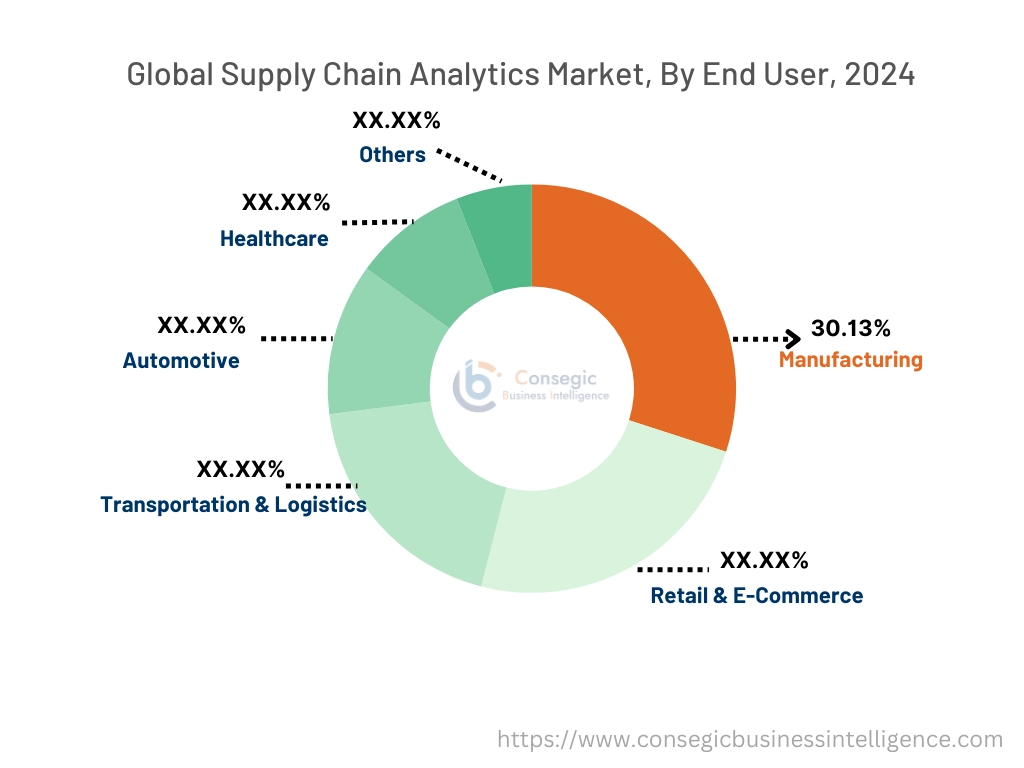
Regional Analysis:
The regions covered are North America, Europe, Asia Pacific, the Middle East and Africa, and Latin America.
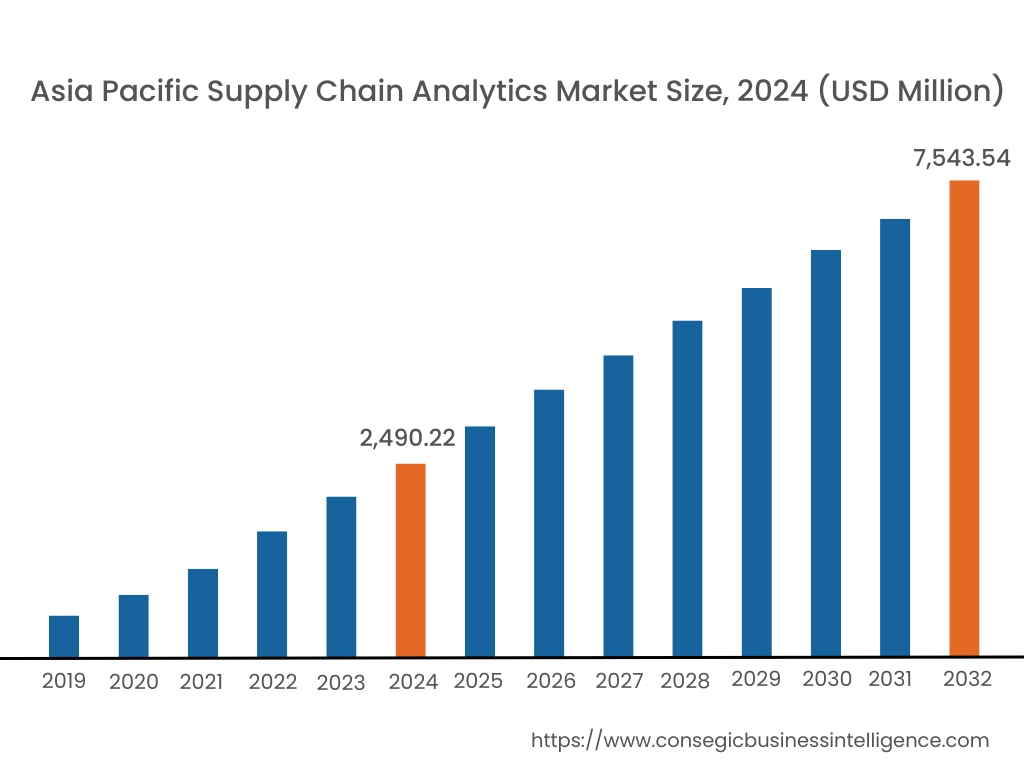
Asia Pacific region was valued at USD 2,490.22 Million in 2024. Moreover, it is projected to grow by USD 2,841.82 Million in 2025 and reach over USD 7,543.54 Million by 2032. Out of this, China accounted for the maximum revenue share of 31.5%. As per the supply chain analytics market analysis, the adoption of supply chain analytic solutions in the Asia-Pacific region is primarily driven by the growing manufacturing, healthcare, and logistics sectors among others. Additionally, the growing retail & e-commerce sector is further accelerating the supply chain analytics market expansion.
- For instance, according to India Brand Equity Foundation, the e-commerce sector in India was valued at USD 93 billion in 2023, and it is projected to grow up to USD 350 billion by 2030. Therefore, the above factors are further anticipated to boost the market in the Asia-Pacific region during the forecast period.
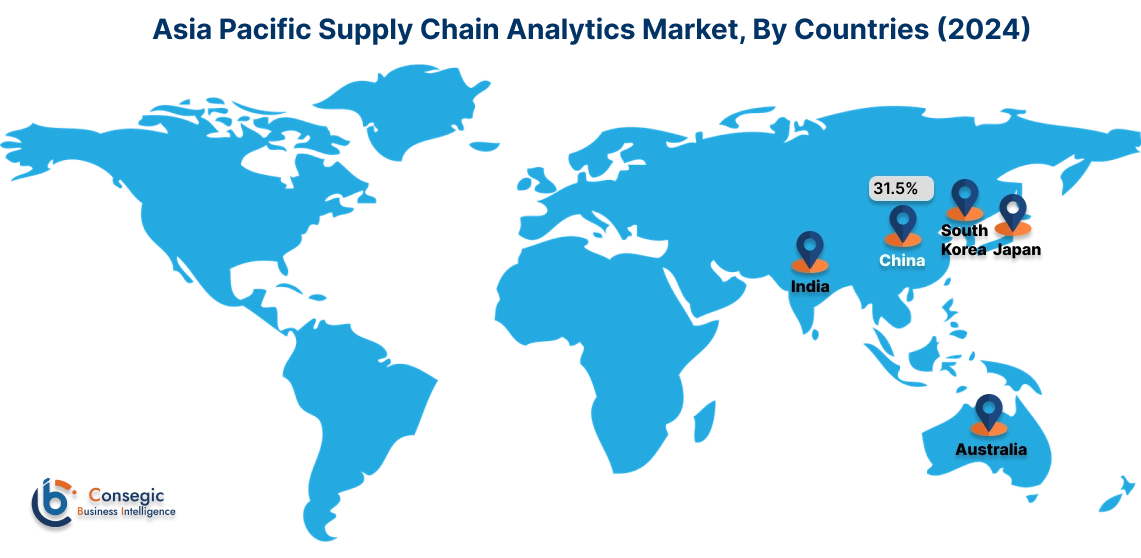
North America is estimated to reach over USD 9,472.47 Million by 2032 from a value of USD 3,225.80 Million in 2024 and is projected to grow by USD 3,671.60 Million in 2025.
In North America, the growth of supply chain analytics industry is driven by the growing investments in manufacturing, healthcare, retail & e-commerce, and other sectors. Moreover, the increasing adoption of supply chain analytic solutions in manufacturing sector for facilitating inventory optimization, production planning, and warehouse efficiency is contributing to the supply chain analytics market demand.
Additionally, the regional analysis depicts that the growing manufacturing, automotive, and transportation & logistics sectors are driving the supply chain analytics market demand in Europe. Furthermore, as per the market analysis, the market demand in Latin America, Middle East, and African regions is expected to grow at a considerable rate due to factors such as increasing development of retail & e-commerce business, expansion of healthcare facilities, and rising manufacturing sector among others.
Top Key Players and Market Share Insights:
The global supply chain analytics market is highly competitive with major players providing solutions to the national and international markets. Key players are adopting several strategies in research and development (R&D), product innovation, and end-user launches to hold a strong position in the supply chain analytics market. Key players in the supply chain analytics industry include-
- IBM Corporation (U.S)
- SAS Institute Inc. (U.S)
- Oracle Corporation (U.S)
- Analytics8 LLC (U.S)
- SS Supply Chain Solutions (3SCS) (Netherlands)
- Mecalux S.A. (Spain)
- Sigmoid Analytics (U.S)
- Salesforce Inc. (U.S)
- SAP SE (Germany)
- Manhattan Associates (U.S)
Recent Industry Developments :
Product Launch:
- In April 2024, SAP SE introduced AI advancements in its supply chain solutions for utilization in manufacturing sector. The supply chain solution offers AI-driven insights from real-time data for optimizing supply chain operations, streamlining product development, and enhancing overall manufacturing efficiency.
- In April 2023, Oracle announced new capabilities across Oracle Fusion Cloud Applications Suite. The supply chain solution assists customers in accelerating supply chain optimization & planning, improving financial accuracy, and increasing operational efficiency.
Supply Chain Analytics Market Report Insights :
| Report Attributes | Report Details |
| Study Timeline | 2018-2032 |
| Market Size in 2032 | USD 26,902.79 Million |
| CAGR (2025-2032) | 16.2% |
| By Type |
|
| By Component |
|
| By Deployment |
|
| By Enterprise Size |
|
| By End User |
|
| By Region |
|
| Key Players |
|
| North America | U.S. Canada Mexico |
| Europe | U.K. Germany France Spain Italy Russia Benelux Rest of Europe |
| APAC | China South Korea Japan India Australia ASEAN Rest of Asia-Pacific |
| Middle East and Africa | GCC Turkey South Africa Rest of MEA |
| LATAM | Brazil Argentina Chile Rest of LATAM |
| Report Coverage |
|
Key Questions Answered in the Report
How big is the supply chain analytics market? +
The supply chain analytics market was valued at USD 9,163.80 Million in 2024 and is projected to grow to USD 26,902.79 Million by 2032.
Which is the fastest-growing region in the supply chain analytics market? +
Asia-Pacific is the region experiencing the most rapid growth in the supply chain analytics market.
What specific segmentation details are covered in the supply chain analytics report? +
The supply chain analytics report includes specific segmentation details for type, component, deployment, enterprise size, end user, and region.
Who are the major players in the supply chain analytics market? +
The key participants in the supply chain analytics market are IBM Corporation (U.S), SAS Institute Inc. (U.S), Oracle Corporation (U.S), Analytics8 LLC (U.S), SS Supply Chain Solutions (3SCS) (Netherlands), Mecalux S.A. (Spain), Sigmoid Analytics (U.S), Salesforce Inc. (U.S), SAP SE (Germany), Manhattan Associates (U.S), and others.
